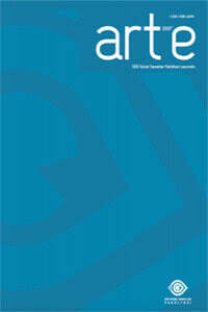FRANS MASEREEL VE AĞAÇ BASKI ROMANI TUTKULU YOLCULUK
Yirminci yüzyıl başlarında, özellikle Birinci Dünya Savaşı sonrasında, Avrupalı sanatçılar grafik sanatlar alanında 'ağaç baskı roman' adını verdikleri özgün bir Dışavurumcu estetik geliştirmiştir. Sözcük kullanmadan, yalnızca ardışık imgeler serisiyle hikaye anlatım türü olarak tanımlanabilecek ağaç baskı roman, birçok grafik roman sanatçısına ilham olmuştur ve günümüzde grafik romanın atası olarak kabul edilmektedir. Dışavurumculuk olmak üzere erken yirminci yüzyılın çeşitli sanatsal ve politik akımlarından etkilenmiş olan ağaç baskı roman, dışavurumsal bir üslup benimsemiş ve çoğunlukla ağaç baskı olmak üzere yüksek baskı tekniklerinin güçlü grafiksel anlatım gücünden yararlanmıştır.Bu makalede literatür taraması yapılarak, yirminci yüzyılın en önemli grafik sanatçılarından biri ve modern grafik romanın babası kabul edilen Frans Masereel'in ağaç baskı romanların gelişimine yaptığı önemli katkıların değerlendirmesi yapılmış ve sanatçının 1919 yılında yayımladığı en ünlü ağaç baskı romanlarından biri olan Tutkulu Yolculuk romanı analiz edilmiştir
FRANS MASEREEL AND HIS W OODCUT NOVEL PASSIONATE JOURNEY
During the early twentieth century, particularly after the World War I, Europeanartists developed a distinctive Expressionist aesthetics in the graphic arts, called as'woodcut novel'. Woodcut novel that can be defined as a means of telling a narrativemerely with a series of sequential images linked thematically, without using anyword, influenced many graphic artists, and is regarded as the predecessor of graphicnovels today. The genre that drew inspiration from various artistic and politicalcurrents of the early twentieth century adopted an Expressionist manner, and usedthe strong graphically way of expression of relief printmaking methods, mostlywoodcut.The significant contributions on the development of the genre made by FransMasereel who is considered as one of the most important graphic artists of the timeand the godfather of modern graphic novel will be discussed in this article by using literature review method. Later, his most successful novel in woodcut entitledPassionate Journey will be reviewed.
___
- Antonsen, L. B., (2004). "Frans Masereel:Passionate Journey", H arvard R eview , Sayı: 27, 154-155.
- Berona, D., (2003). "Wordless Novels in Woodcuts", P rin t Q u a rterly, Cilt:20, Sayı: 1, 61-73.
- Berona, D., (2007). "Introduction". Frans Masereel: Passionate Journey: A Vision in W oodcuts, New York: Dover Publications,. ss. v-ix.
- Berona, D., (2008). W ordless Books:The Original Graphic Novels, New York: Abrams Books.
- Berona, D., (2009). "Introduction", The Sun, The Idea and S tory W ithout Words, Frans Masereel, New York: Dover Publications, ss. v-viii.
- Cohen, M., (1977). "The Novel in Woodcuts: A Handbook", Jo u rn a l o f Modern L ite ra tu re , Cilt: 6, Sayı: 2, 171-195.
- Lanier, C., (1998). "Frans Masereel: A Thousand Words", The C o m ics Jo u rn a l, Sayı: 208, 109-117.
- Walker, G. A., (2007). Graphic W itness: Four W ordless Graphic Novels by Frans Masereel, Lynd Ward, Giacomo Patri and Laurence Hyde, New York: Firefly Books.
- Willett, P., (1997). The Silent Shout: Frans Masereel, Lynd Ward and the Novel in W oodcuts, Indiana University Libraries.
- Willett, P., (2005). "The Cutting Edge of German Expressionism: The Woodcut Novel of Frans Masereel and Its Influences", A Companion to theLiterature of German Expressionism , (der.) Neill H. Donahue, New York:Camden House, 111-134.
- Yayın Aralığı: Yılda 2 Sayı
- Başlangıç: 2008
- Yayıncı: Süleyman Demirel Üniversitesi Güzel Sanatlar Fakültesi
Sayıdaki Diğer Makaleler
SAHNE TASARIM INDA ÇOK YÖNLÜ BİR İSİM: ES DEVLİN
Art-e Cilt:9 Sayı:18 Kapak Arkası
SERAMİK SANATI VE YUNUS EMRE FELSEFESİ
MARK ROTHKO'NUN "SEAGRAM RESİMLERİ" 'NDE MEKÂNA YAYILAN SESSİZLİK
FRANS MASEREEL VE AĞAÇ BASKI ROMANI TUTKULU YOLCULUK
AĞAÇ YAZMA KALIPLARINA ALTERNATİF KALIPLAR
TİYATRODAN STADYUM SAHNELERİNE UZANAN TASARIMLARIYLA : ES DEVLİN
OYUNCULUKTA FİZİKSEL EYLEMLER YÖNTEMİNİN ANALİZİ
